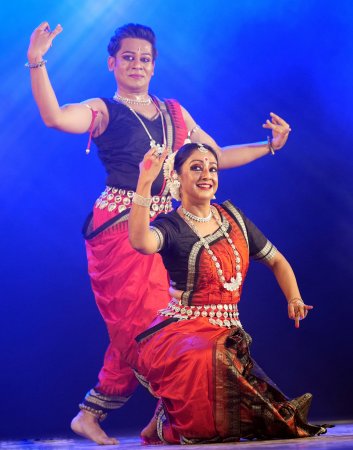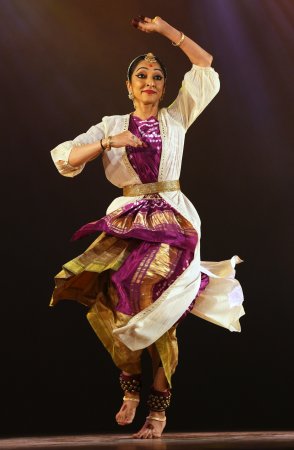
|   |

|   |
Pravaha Dance Festival - Satish Suri e-mail: satishism@yahoo.co.in Photos: Prof. K.S. Krishnamurthy May 4, 2025 'Pravaha' organised by the Sanjali Centre for Odissi Dance under Sharmila Mukerjee's leadership, on the 12th of April at the A.D.A Rangamandira, Bangalore, was a beautiful and heartfelt tribute to Guru Kelucharan Mohapatra. The event showcased the richness of Indian classical dance and honoured the Guru's immense contribution to Odissi and the broader cultural landscape.  Srijita Sanyal and Surajit Som Under Sharmila Mukerjee's guidance, Srijita Sanyal and Surajit Som brought Adi Shankaracharya's Ardhanarishwara Stotra to life through a choreography that embodied the essence of divine duality. Originally conceived by Guru Kelucharan Mohapatra, the piece unfolded as a dialogue between contrasting energies - Shiva's vigorous tandava and Parvati's fluid lasya. The dancers mirrored each other yet remained distinct - his sharp, angular movements and explosive footwork contrasting with her circular grace and delicate gestures. When their paths crossed, their figures briefly formed living sculptures of the Ardhanarishwara form. Musically, Shiva's sequences aligned with percussive bursts and asymmetric rhythms, while Parvati's flowed with melodic phrases. Their meeting points resolved in rhythmic unison, visually echoing the stotra's philosophical core - that apparent opposites are, in truth, inseparable. Sharmila Mukerjee's restaging honoured Guru Kelucharan Mohapatra's foundation while adding subtle innovations. The partnering became more intricate, with Parvati's spiralling motions weaving around Shiva's anchored presence. Narrative layers emerged organically, like when Shiva's fierce staccato gradually softened into lasya, illustrating the dissolution of duality. The performance transcended the mere depiction of deities through precise technique and nuanced abhinaya. It became a moving meditation on cosmic balance, where every stamp of Shiva's foot and every ripple of Parvati's hands whispered the same truth: power and grace, movement and stillness, are only two expressions of one infinite consciousness. The presentation unfolded through Ragamalika and Talamalika, weaving a rich tapestry of melodic and rhythmic textures that mirrored the Ardhanarishwara theme. Each shift in raga and tala subtly underscored the transition between Shiva's and Parvati's energies. This musical complexity elevated the choreography, making the dance not just a visual but an auditory embodiment of unity in diversity, where varied ragas and talas coexisted in harmony, just as the divine masculine and feminine unite in Ardhanarishwara. The Pallavi in Brindavani Saranga and Ektali unfolded as a masterful exploration of pure dance, where Sharmila Mukerjee's intricate choreography came alive through Srijita Sanyal and Surajit Som's precise execution. Set to Srijan Chatterjee's melodic interpretation and Dhyaneswar Swain's dynamic rhythmic composition, the piece wove together nritta with sculptural poses, creating a mesmerising interplay of geometry and rhythm. The Brindavani Saranga raga lent a lyrical yet vibrant quality, its bright, emotive phrases enhancing the dancers' fluid transitions between sharp and supple movements. In Ektali's 12-beat cycle, the choreography emphasised mathematical precision, footwork patterns, and rhythmic motifs echoed the percussive syllables, while sudden pauses and syncopations added dramatic tension. Sharmila Mukerjee's vision shone through the stylised poses, where moments of frozen stillness - like a chauka stance or a dynamic tribhangi - served as visual punctuation between rapid sequences. The interwoven nritta wove intricate patterns around the tala, with the dancers' bodies becoming instruments that mirrored the music's ebb and flow. The Pallavi's brilliance lay in its balance of technical rigour and aesthetic grace, where every step, spin, and gesture was both a celebration of Odissi's classical grammar and an innovative expansion of its expressive possibilities. The rhythmic and melodic complexity elevated the piece beyond mere virtuosity, transforming it into a meditation on movement, structured yet spontaneous, disciplined yet divine.  Prathibha Ramaswamy Prathibha Ramaswamy unveiled from the pages of history, the story of Krishnakumari, which is less celebrated than other Rajput legends like Padmini, likely because her death by poison, rather than a dramatic act like Jauhar (self-immolation), was seen as less verifiable. No ballads or films have immortalised her, yet her sacrifice underscores the harsh realities of Rajput politics and the limited agency of women in that era. Prathibha Ramaswamy's Bharatanatyam presentation on the story of Krishnakumari offered a haunting exploration of forgotten history through poetry, movement, and visual metaphor. Inspired by the evocative verse of D.R. Bendre, who used the chilling image of a woman taking three sips of poison, the performance unfolded with quiet intensity, shedding light on a tale often excluded from the grand narratives of Rajput valour. The dance moved beyond conventional portrayals of historical sacrifice to reveal a deeper emotional truth. Krishnakumari, a princess of Mewar, did not meet her end in the dramatic spectacle of Jauhar, but in the suffocating silence of political compromise. Prathibha's choreography traced the gradual erasure of agency, each gesture echoing the layers of betrayal. Krishnakumari's act of taking three sips of poison became more than a moment of coerced death - it was transformed into a quiet act of transcendence. Through Prathibha's interpretation, each sip symbolised a release from the bindings of the three gunas - tamas (inertia), rajas (passion), and sattva (harmony) - which, in Indian philosophy, govern all material existence. This spiritual reading reframed Krishnakumari's death not as a surrender, but as a passage beyond the worldly forces that had defined and constrained her life. She moved past tamas, the despair imposed upon her; past rajas, the storm of ambition and conflict that surrounded her; and even past sattva, the illusion of virtue cloaking the choices made by others in her name. In transcending the gunas, Krishnakumari shed the roles forced upon her - as pawn, princess, and symbol - and stepped into a space of inner liberation. It was in this final act, stripped of all grandiosity, that she reclaimed her voice. Not in speech, but in presence. Not in protest, but in stillness. Her silence became its form of truth - one that resisted erasure and demanded remembrance. Through dance, gesture, and the poetic metaphor of the three sips, the performance granted Krishnakumari the dignity of transformation, allowing her spirit to rise beyond history's confines and be seen, perhaps for the first time, as fully, achingly human. A white robe served as a central visual motif, representing the moon, the narrator, and Krishnakumari herself. This shared costuming allowed the performer to shift between personas while drawing a symbolic link between them. The white, often associated with purity and mourning, became a quiet signifier of both the princess's innocence and the pall of silence that followed her death. The narrative flowed seamlessly, weaving the story through a delicate balance of stillness and movement, presence and absence. In the final scene, the narrator returned as the moon, a silent witness to Krishnakumari's death on Amavasya, the new moon night. This choice imbued the ending with a sense of cosmic lament. The absence of the moon became a metaphor for the erasure of her story, and yet its cyclical return offered a sense of remembrance. The moon, unaffected by time or politics, stood as a testament to a life forcibly extinguished, and to many others like it. Through this device, the performance shifted from a historical retelling to a meditation on memory, silence, and the cost of honour. Prathibha Ramaswamy's presentation did not seek to dramatise but to illuminate. It asked uncomfortable questions, not with confrontation but with grace. In doing so, it brought dignity to life denied its rightful place in history and invited the audience to bear witness alongside the moon. The music composition by Mahesha Swamy, his sensitive handling of the score complemented by his flute playing, evoked a sense of longing and quiet tragedy that underscored the narrative. The inclusion of the sarangi, along with Sarfraz Khan's evocative vocals, added a textured, almost plaintive quality that resonated with the inner world of Krishnakumari. Arun Kumar's percussion provided rhythmic precision without overpowering the mood, while Venugopal's keyboard work created a subtle sonic backdrop that helped transition between scenes and emotional states. The production further benefited from the collaborative inputs of Dr. Raghu, Vijayraghava, and Janani Murali, whose contributions refined the musical and dramaturgical structure, ensuring the music not only supported the dance but became an active participant in the storytelling. This cohesive musical ensemble enhanced the emotive fabric of the performance and deepened the audience's engagement with its themes.  Nrityagram Ensemble 'Aakriti' - a term rooted in Sanskrit, evoking notions of form, shape, and embodiment and performed by Pavithra Reddy, Anoushka Rehman and Daquil Miriyala, found luminous expression in Surupa Sen's visionary choreography. Drawing from the deeply sculptural vocabulary of Odissi, the work unfolded as a living tribute to the dance form's architectural lineage. Every movement seemed to emerge from the stone reliefs of ancient temples, only to dissolve back into the ether as if the very essence of the art had momentarily stepped out of time. Sen's choreography was a study in contrasts - curves and angles, fluidity and precision, repose and velocity - woven together with breathtaking finesse. The three dancers etched space with a rigorous clarity, their bodies configured into geometric mandalas and filigreed arcs that shifted with choreographic intelligence. What made 'Aakriti' so compelling was the seamless interlacing of nritta and nritya. In pure dance passages, footwork cascaded with rhythmic virtuosity, only to be arrested by a sudden stillness - a visual punctuation that drew attention to form and breath. These pauses were not inert; they vibrated with latent energy, like sculptures poised at the brink of motion. The ensemble work was particularly striking. In synchronised sequences, dancers' bodies intertwined to form intricate visual tableaux, invoking the mandala not just as a symbol but as an embodied aesthetic. The spatial design was meticulous, each figure placed with painterly attention, creating shifting symmetries that invited contemplation. Equally compelling were the moments of abhinaya - those flickers of expression where the abstract yielded to the intimate. A glance, a smile, the faintest quiver of a brow - these subtle gestures imbued the choreography with human presence, momentarily transforming sculptural stillness into lived narrative. Through these vignettes, the work navigated between the tangible and the ephemeral, between the mythic and the personal.  Surupa Sen "Kuru Yadu Nandana," the song of union, became much more than a performance in the hands of Surupa Sen - it became a deeply personal offering that resonated with artistic, emotional, and spiritual significance. Set to the exquisite poetry of Jayadeva's Gita Govinda, the ashtapadi celebrates the divine love of Radha and Krishna. In this evocative composition, Radha, basking in the afterglow of their union, playfully entreats Krishna to restore her dishevelled appearance, asking him to reapply sandal paste to her body, smooth her tousled hair, and return her ornaments. This tender exchange, layered with affection and charm, is as much about intimacy as it is about surrender. Yet, beneath its sensual lyricism lies a profound metaphysical allegory. The ashtapadi blends sringara rasa with bhakti, portraying the union of the jivatma with the paramatma. In this moment, Radha becomes the eternal seeker, and Krishna the divine beloved, together embodying the soul's longing and blissful fulfilment in divine communion. For Sen, the piece carried deep emotional weight - both a tribute and a homecoming. She returned to the very venue where she had first performed this piece decades earlier, in the presence of Guru Kelucharan Mohapatra. That history imbued her rendition with a sense of time collapsed, of lineage remembered. Adding to its poignancy was the memory of how the piece had first been taught by Protima Gauri, who, though bedridden, summoned immense strength and clarity to transmit the composition to her disciple during daily hospital visits. These were not just movement lessons, but acts of devotion - both to the art and to the guru-shishya bond that sustains it. Sen's interpretation honoured this lineage with grace and gravity. Her abhinaya was refined and inward, marked by emotional precision and a quiet radiance that let the poetry breathe. She did not merely depict Radha; she became the soul in the union, her gestures speaking not only of romantic delight but of spiritual intimacy. The choreography remained rooted in the classical idiom, reflecting Kelucharan Mohapatra's stylistic purity, yet it bore the unmistakable imprint of Sen's artistic evolution - subtle inflexions and pauses that revealed years of introspective practice. Through "Kuru Yadu Nandana," Surupa Sen offered more than a celebration of Radha and Krishna's divine love. She celebrated the continuum of the Odissi parampara - a testament to how classical dance, when imbued with soul and memory, transcends time and becomes eternal. The final presentation "Shree Devi" performed by the ensemble of Pavithra Reddy, Anoushka Rehman, and Daquil Miriyala, was a resounding invocation of the Divine Feminine - at once fierce, majestic, and transcendent. The three dancers moved as one living embodiment of the Goddess, their synchronised forms dissolving into individual expressions before merging back into unity, much like Devi's countless manifestations springing from and returning to the divine source. As the opening chant of "Ayi Giri Nandini" reverberated through the space, their bodies became conduits for primordial energy, each precise movement vibrating with sacred intention. In the depiction of Devi's battle with Mahishasura, their dancing transformed into a kinetic storm - sharp angular gestures cutting through space like divine weapons, stamping feet, shaking the earth with cosmic fury. Yet within this tempest of movement appeared moments of sublime stillness - a perfectly held stance becoming the unmoving axis around which the chaos of battle swirled, embodying the paradox of the Goddess who is both the dance and the dancer. The choreography's brilliance lay in its layered storytelling. When portraying the slaying of Chanda and Munda, the dancers created a visceral sense of combat through rhythmic intensity - their feet drumming intricate footwork patterns that mirrored the stotra's escalating tempo, their spinning bodies leaving afterimages. Then, in sudden contrast, they would freeze in sculptural poses that seemed to step directly from temple walls, their mudras forming perfect iconographic representations of the Devi. As the piece progressed towards its climax, the dancers' movements took on a transcendent quality. Their circular patterns around the stage became a spinning mandala, their interweaving paths tracing the cosmic cycles of creation and dissolution. The final moments dissolved into slow, deliberate movements - each extension of an arm, each turn of the head radiating a sacred power that seemed to emanate from beyond the performers themselves. In this meditative culmination, the boundary between the worshipped and the worshippers blurred, the dancers' very presence becoming the living murti of the Goddess they celebrated. Every element - from the mathematical precision of their formations to the devotional intensity in their expressions- served to manifest the eternal truth of the Devi Stotram: that the divine feminine is not merely invoked, but recognised as ever-present, waiting to be revealed through the disciplined artistry of those who dance in her honour. Pravaha Dance Festival formed a resonant arc - from form to feeling, discipline to devotion, human to divine, proving once more that tradition thrives most vibrantly when it is felt, lived, and loved anew.  Bangalore based Satish Suri is an avid dance rasika besides being a life member of the Music and Arts Society. |